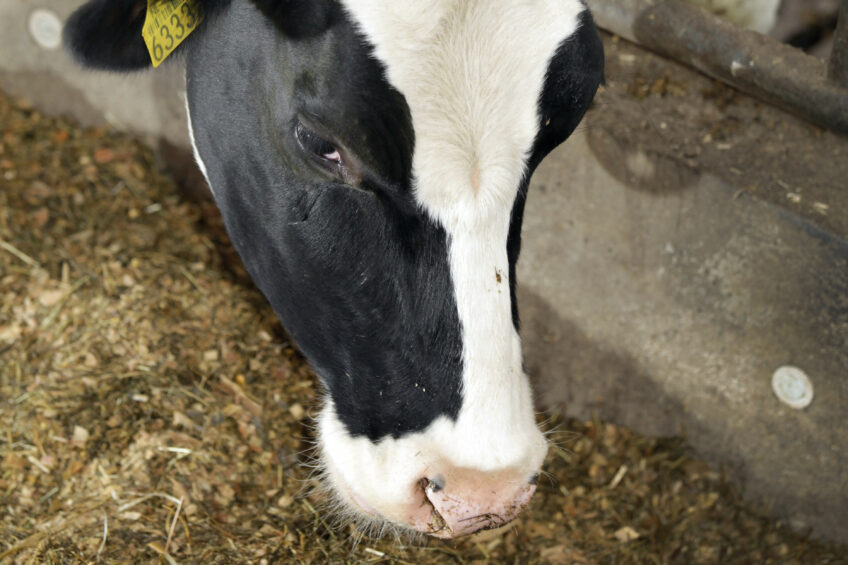Effect of malic acid in dairy cow diets

Malic acid is an organic acid naturally found in many forages, but it can also be supplemented. But do they also have health benefits for dairy cows? In this review we delved into some of the data.
Malic acid is a 4-carbon dicarboxylic acid intermediate in the succinate–propionate pathway of ruminal bacteria. Research has shown that malic acid can stimulate the growth of Selenomonas ruminantium, improving the ruminal environment and increasing propionate production.
This microorganism is the predominant specie in the rumen, representing from 21 to 51% of the total viable rumen bacteria. In vitro, malic acid has increased concentrations of propionate and total volatile fatty acids, increased pH, decreased methane production and lactate concentration, and increased digestibility of dry matter (DM), organic matter, neutral detergent fibre (NDF). Malic acid can be added to the diet either as the free acid, or as a salt (for example, calcium malate or sodium malate). Studies conducted in vitro showed that the effect of the free malic acid in the rumen is similar to the effect of disodium malate, although malic acid supplies the ruminal fluid with protons, which contributes to decrease ruminal pH.
Martin et al. (1999) found when forage samples were incubated in rumen fluid malate solubilised and disappeared very rapidly (within 30 minutes). The authors suggested that dietary supplementation with malate may be necessary to ensure adequate rumen concentrations throughout the feeding cycle. Although in vitro studies have shown positive effects of malic acid on rumen fermentation, in vivo studies that evaluate the effects of malic acid on dairy cow performance are inconclusive.
Studies in lactating dairy cows
The evaluation of malic acid in dairy cow diets is very limited and their results are variable:
- Stallcup (1979) fed cows a diet with 0, 28, or 70 g supplemental malic acid per cow per day. This researcher reported that cows fed 70 g of malic acid had higher milk yield than cows fed 0 g malic acid. In a second trial, cows fed a diet with 100 g supplemental malic acid had higher solids-corrected milk and milk fat content than cows fed the diet with no supplemental malic acid. In a study from Michigan State University (Kung et al., 1982), early and mid-lactation lactating cows were fed either 0, 70, 105, or 140 g of malic acid per day. Malic had no significant effects on DM intake or milk yield; however, cows fed 140 g of malic acid were significantly greater in persistency of milk production than other treatments.
- More recently, Researchers from the W. H. Miner Agricultural Research Institute, New York (Sniffen et al., 2006), evaluated the effect of malic acid supplementation on lactation performance of mid-lactation dairy cows. Cows were fed one of two diets: a diet that contained 0 g of supplemental malic acid per cow per day or a diet that contained 50 g of supplemental malic acid per cow per day (998 g/kg malic acid). The authors reported dairy cows fed supplemental malic acid increased milk yield (1.5 kg or 4.1%), and energy corrected milk (1.3 kg or 3.3%) compared to non-supplemented cows. There was no effect of malic acid supplementation on content of fat or protein in milk. However, yield of milk protein was higher for cows fed supplemental malic acid because of higher milk yield. The authors concluded “inclusion of malic acid as a feed additive in diets for dairy cows is expensive ($ 0.11 per cow per day) and may not be economically feasible at that time; however, forages high in organic acids might provide a vehicle for inclusion of malic acid in diets for dairy cows.”
- Wang et al. (2009) studied the effect of supplementing malic acid at 0, 70, 140 and 210 g per cow per day during the first 3 weeks of lactation. Although feed intake and milk components were not affected by malic acid supplementation, milk yield and feed efficiency increased linearly as malic acid supplementation increased. Body condition score, body weight change, and energy balance tended to be higher in malic
acid supplemented cows. Concentrations of glucose in plasma and insulin in serum increased linearly with increasing malic acid supplementation. Moreover, blood concentrations of β-hydroxybutyric acid and non-esterified fatty acids decreased linearly as malic acid in the diet decreased. Similarly, concentrations of urine ketones decreased with decreasing malic acid supplementation. - An experiment was conducted in a commercial farm to evaluate the effect of pre- and post-partum supplementation of malate on milk production (Devant et al., 2011). Before calving cows were fed a total mixed ration and 1 kg of either malate or control concentrate. After calving the concentrate (malate or control) was gradually (300 gram per day) increased to reach daily consumption of 3 kg/day, providing approximately 84 g/day/cow of malate. Malate supplementation did not affect milk production nor milk fat and protein concentrations.
Factor affecting response
The contrasting results could be due to differences in animals, dietary factors (forage/concentrate ratio and forage type), and dose of malate. Dietary factors are important in determining the response to malate supplementation because the content of malic acid in the basal diet will vary, and may explain the variable results obtained in previous studies. Malic acid content has ranged in alfalfa from 2.4% to 7.5% DM; bermuda grass (1.9 to 4.5% DM), clover (3.5% DM), and switch grass (1.0% DM). Malate has not been detected in maize silage or grasses such as; orchard grass, smooth brome grass, and oat straw. In addition, its concentration in forages depends on variety, maturity, moisture content, and forage processing.
Conclusion
There was a wide range in supplementation level of malic acid across the reported studies, and it is unclear which is the ideal dosage of malic acid for lactating cows. More research evaluating the effects of malic acid on performance and health of dairy cows is needed.
Join 13,000+ subscribers
Subscribe to our newsletter to stay updated about all the need-to-know content in the dairy sector, two times a week.












